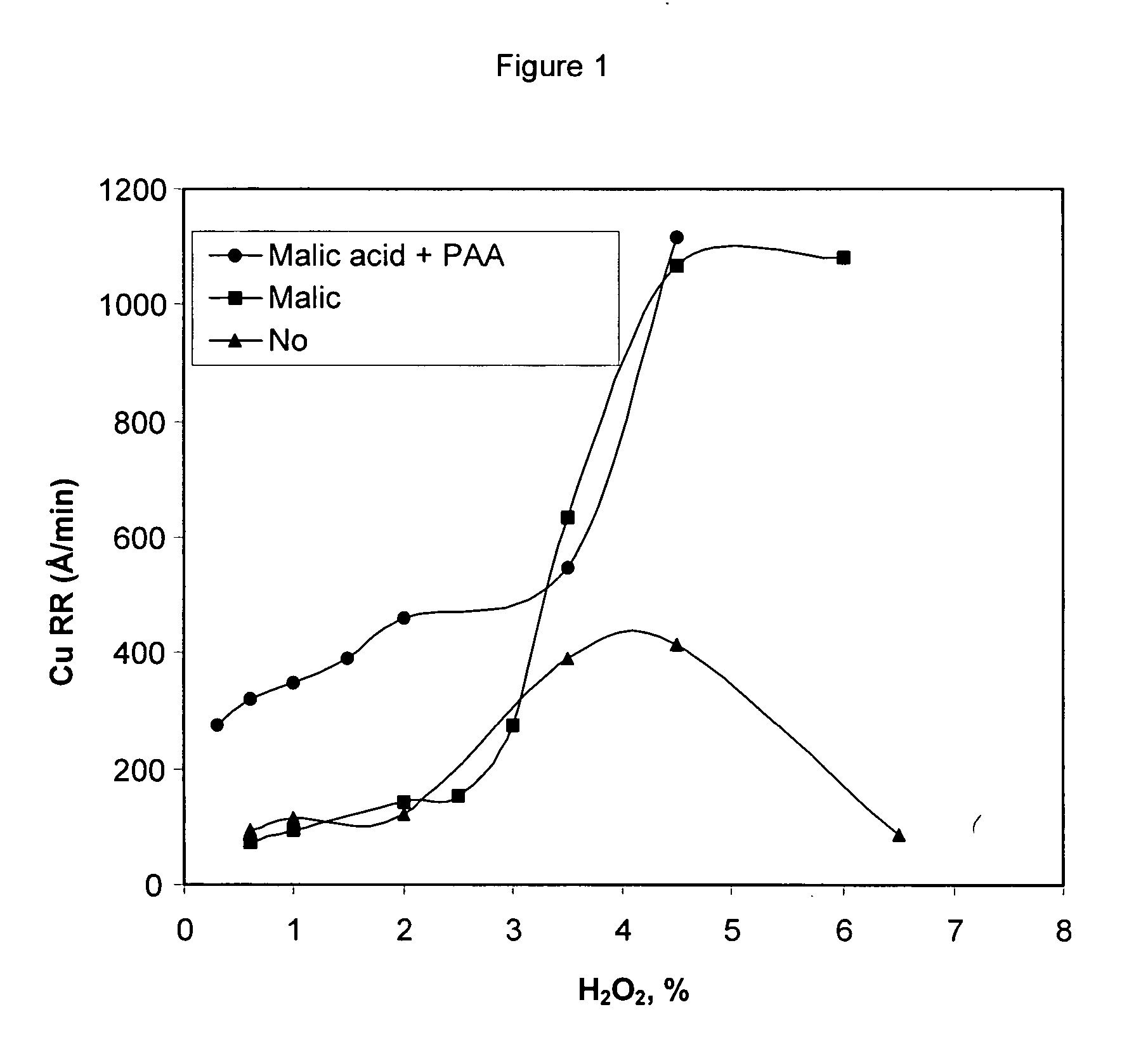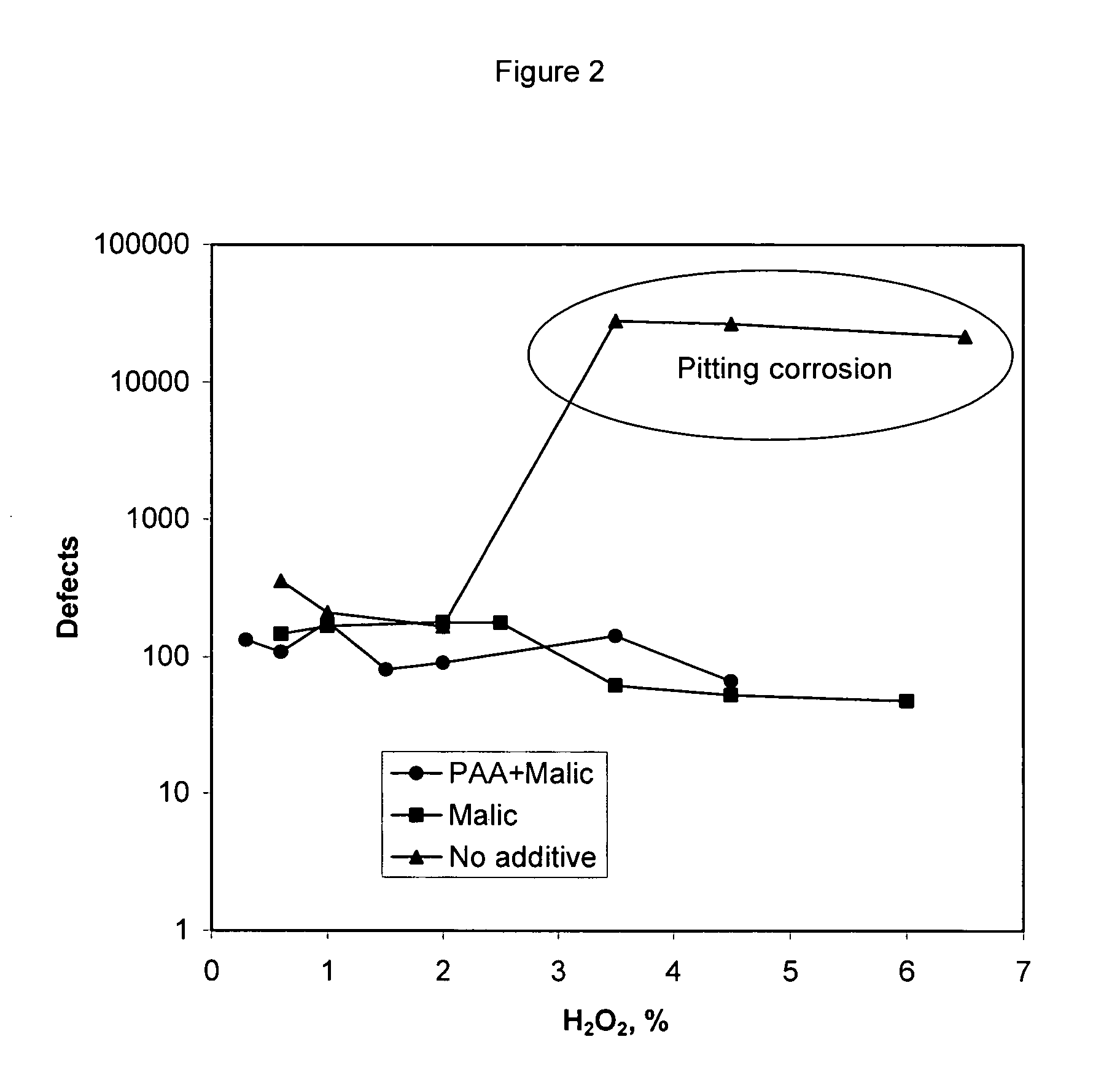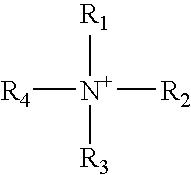Corrosion-resistant barrier polishing solution
- Summary
- Abstract
- Description
- Claims
- Application Information
AI Technical Summary
Benefits of technology
Problems solved by technology
Method used
Image
Examples
example 1
[0040] A list of solution compositions shown in Table 1 were prepared to evaluate the performance of malic acid and polyacrylic acid at varying concentration levels. In the preparation of the compositions the requisite amounts of all required chemicals as shown in Table 1 (with the exception of the hydrogen peroxide and the abrasive) were added to deionized water in a container. The solution in the container was stirred until all the ingredients are dissolved in water. The abrasive was then added to the container. The pH of the solution was then adjusted to the target pH by the addition of nitric acid. Following this, the hydrogen peroxide was added to the container for use as a polishing composition. For purposes of this specification, letters represent comparative examples and numbers represent examples of the invention. Comparative slurries A-F, without any copper removal agents, were used as a control.
TABLE 1Poly(acrylic)Poly(acrylic)acid, M.W.acid, M.W.BTATBAHEDTA180030,000Ma...
example 2
[0043] This Example compares the removal rate effectiveness for polyacrylic acid having two different molecular weights and various hydrogen peroxide levels using the slurries and conditions of Example 1.
TABLE 3Poly(acrylic)Poly(acrylic)acid, M.W.acid, M.W.1,80030,000Malic acidH2O2Cu RRTaN RRTEOS RRSlurry(wt %)(wt %)(wt %)(wt %)(Å / min)(Å / min)(Å / min)A0.66114961076150.10.6166108590.10.20.61601344900100.10.211881371120.10.223321499160.10.243591547170.10.2916421435180.10.6121894349190.10.20.61251112409200.10.21138942210.10.222011093220.10.243541102230.10.2911111389
[0044] Table 3 illustrates that low molecular weight polyacrylic acid (1,800 number average molecular weight) and high molecular weight polyacrylic acid (30,000 number average molecular weight) each increase copper removal rate. The low molecular weight polyacrylic acid, however, has less negative effect on TEOS removal rate than high molecular weight polyacrylic acid.
example 3
[0045] The polishing was performed using Strausbaugh 6EC polishing tool. The polishing pad was a POLITEXυ porous polyurethane pad supplied by Rohm and Haas Electronic Materials CMP Technologies. The pad was conditioned prior to each run with a diamond abrasive plate manufactured by Kinik having 180 μm diamonds. The polishing process was performed at a membrane pressure of 10.33 kPa (1.5 psi), a table speed of 93 revolutions per minute (rpm) and a carrier speed of 87 rpm. The polishing composition apply rate was 200 ml / min using 200 mm blanket wafers. Cu and TaN removal rates were measured on a Four-Point Probe CDE Resmap. TEOS and Coral® carbon-doped oxide (CDO) film removal rates were measured by a ThermaWave Optiprobe® 2600 metrology tool.
[0046] Table 4 below provides barrier slurries compositions with a poly(acryliamide-co-acrylic) acid copolymer and polyacrylic acid with various amounts of hydrogen peroxide.
TABLE 4Poly(acryli-amide-co-acrylicPoly(acrylic)acid) M.W.acid, M.W.B...
PUM
| Property | Measurement | Unit |
|---|---|---|
| Fraction | aaaaa | aaaaa |
| Fraction | aaaaa | aaaaa |
| Percent by mass | aaaaa | aaaaa |
Abstract
Description
Claims
Application Information
 Login to View More
Login to View More - R&D
- Intellectual Property
- Life Sciences
- Materials
- Tech Scout
- Unparalleled Data Quality
- Higher Quality Content
- 60% Fewer Hallucinations
Browse by: Latest US Patents, China's latest patents, Technical Efficacy Thesaurus, Application Domain, Technology Topic, Popular Technical Reports.
© 2025 PatSnap. All rights reserved.Legal|Privacy policy|Modern Slavery Act Transparency Statement|Sitemap|About US| Contact US: help@patsnap.com



